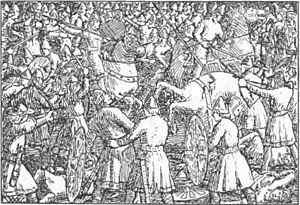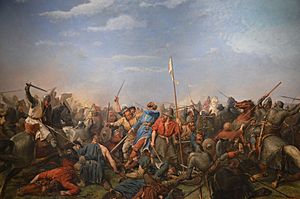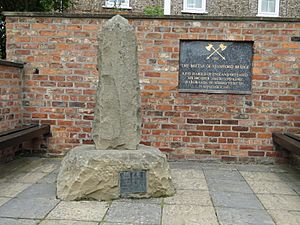Battle of Stamford Bridge facts for kids
Quick facts for kids Battle of Stamford Bridge |
|||||||
|---|---|---|---|---|---|---|---|
| Part of the Viking invasions of England | |||||||
 |
|||||||
|
|||||||
| Belligerents | |||||||
| Kingdom of England |
|
||||||
| Commanders and leaders | |||||||
|
|||||||
| Strength | |||||||
|
|
||||||
| Casualties and losses | |||||||
| 5,000 | 6,000–8,000+ dead or missing | ||||||
The Battle of Stamford Bridge was a major fight that happened in England on September 25, 1066. It took place near the village of Stamford Bridge, East Riding of Yorkshire. The battle was between the English army, led by King Harold Godwinson, and an invading army from Norway. The Norwegian forces were led by King Harald Hardrada and King Harold's own brother, Tostig Godwinson.
After a very tough battle, both King Harald and Tostig were killed. Most of the Norwegian soldiers also died. King Harold's army won this battle, pushing back the invaders. However, his victory was short-lived. Less than three weeks later, his army was defeated by the Normans at the Battle of Hastings. This battle is often seen as the end of the Viking Age, even though some Viking attacks continued for a few more decades.
Contents
Why the Battle Happened
A Fight for the Throne
When King Edward the Confessor of England died in January 1066, there was no clear heir. Many powerful people from different parts of Europe wanted to become the new King of England. One of these people was Harald Hardrada, the King of Norway.
The Norwegian Invasion
- According to old records, the Norwegians gathered a huge fleet of about 300 ships to invade England.
- Their army likely had between 7,000 and 9,000 soldiers.
- In September, King Harald Hardrada's forces arrived off the English coast.
- They were joined by Tostig Godwinson, King Harold's brother. Tostig had been exiled from England and was angry with his brother.
Marching on York
In late summer 1066, the invaders sailed up the River Ouse and then marched towards the city of York. On September 20, they fought and defeated a northern English army at the Battle of Fulford, just outside York. After this victory, York surrendered to them. The Norwegians briefly took over the city, collected supplies, and then went back to their ships near Riccall. They offered peace to the people of Northumbria if they would support King Harald's claim to the throne.
Harold's Swift March North
At this time, King Harold was in southern England. He was expecting another invasion, this time from William, Duke of Normandy, who also wanted the English throne. When Harold heard about the Norwegian invasion, he quickly marched his army north. He traveled day and night, covering about 185 miles (298 km) from London to Yorkshire in just four days. This fast march completely surprised the Norwegians.
Harold learned that the Northumbrians were supposed to send more hostages and supplies to the Norwegians at Stamford Bridge. So, Harold rushed through York to attack them there on September 25. The invaders had no idea an enemy army was even close until the English soldiers appeared.
Where the Battle Took Place
The Bridge and River
Old English writings from the time all mention Stamford Bridge by name. They say the battle happened beyond a bridge. Another old account describes part of the battle being fought right across the bridge.
The exact spot of the battle isn't perfectly known. However, sources suggest it happened along the River Derwent, where a wooden bridge once stood. There was likely a flat meadow on the west side of the river and higher ground on the east. The original wooden bridge is long gone, and no old parts of it have been found by archaeologists.
The Battle Unfolds
A Bold Rider
According to one story, before the battle began, a single man rode up to King Harald Hardrada and Tostig. He didn't say his name but offered Tostig his old earldom back if he would turn against Hardrada. Tostig then asked what King Harold would give Hardrada. The rider famously replied, "Seven feet of English ground, as he is taller than other men." This meant that Hardrada and his army would be killed and buried there. The rider then rode back to the English army. Hardrada was impressed by the rider's bravery and asked Tostig who he was. Tostig said it was King Harold Godwinson himself.
The Axeman on the Bridge
The English army's sudden arrival caught the Norwegians off guard. The English advance was slowed down because they had to cross a narrow wooden bridge. An old English story tells of a giant Norse axeman, possibly using a huge Dane Axe. He stood alone on the bridge and held back the entire English army. This axeman supposedly killed up to 40 Englishmen. He was finally defeated when an English soldier floated under the bridge in a half-barrel and stabbed him through the planks from below.
The Main Fight
This delay allowed most of the Norse army to get ready. They formed a "shieldwall" – a strong defensive line where soldiers stood shoulder-to-shoulder with their shields overlapping. King Harold's army then rushed across the bridge, formed their own line, and attacked.
The battle lasted for hours and spread far beyond the bridge. The Norse army had left their heavy armor behind at their ships, which put them at a big disadvantage. Slowly, the Norse shieldwall began to break apart. English troops pushed through, completely surrounding the Scandinavians. King Harald Hardrada was killed by an arrow to his throat, and Tostig was also slain. The Norwegian army fell apart and was almost completely destroyed.
Orre's Storm
Later in the battle, the Norwegians got some help from troops who had been guarding the ships at Riccall. These soldiers were led by Eystein Orre, who was supposed to marry Hardrada's daughter. Some of his men were so tired from rushing to the battle that they collapsed and died. But the rest were fully armed. Their counter-attack, called "Orre's Storm" in Norwegian stories, briefly stopped the English. However, they were soon overwhelmed, and Orre was killed. The Norwegian army was completely defeated. Many fleeing Norsemen drowned while trying to cross rivers.
So many people died in such a small area that people said the field was still white with bleached bones 50 years after the battle.
What Happened Next

A Short Peace
King Harold made a deal with the few Norwegians who survived. This included Harald's son Olaf and Paul Thorfinnsson, the Earl of Orkney. They were allowed to leave England after promising not to attack again. The Norwegians had lost so many men that only 24 ships were needed to carry the survivors home, out of their original fleet of over 300. They went to Orkney for the winter, and Olaf returned to Norway in the spring.
Harold's Final Battle
King Harold's victory at Stamford Bridge didn't last long. Just three days later, on September 28, a second invasion army landed in England. This army was led by William, Duke of Normandy, who had landed in Pevensey Bay on the south coast.
Harold had to immediately turn his tired troops around and force-march them south to stop the Norman army. Less than three weeks after the Battle of Stamford Bridge, on October 14, 1066, the English army was completely defeated. King Harold II was killed at the Battle of Hastings. This marked the beginning of the Norman conquest of England. The heavy losses of English commanders at Stamford Bridge made it easier for the Normans to win.
Monuments to the Battle
There are two monuments in and around the village of Stamford Bridge that remember the battle.
Village Monument
The first memorial is on Main Street (A116) in the village. It has an inscription in both English and Norwegian that says:
THE BATTLE OF STAMFORD BRIDGE
WAS FOUGHT IN THIS NEIGHBOURHOOD
ON SEPTEMBER 25TH, 1066
A marble tablet next to it adds:
THE BATTLE OF STAMFORD BRIDGE
KING HAROLD OF ENGLAND DEFEATED
HIS BROTHER TOSTIG AND KING
HARDRAADA OF NORWAY HERE ON
25 SEPTEMBER 1066
Battlefield Monument
A second monument is located at the actual battlefield site, at the end of Whiterose Drive. It has a memorial stone and a plaque that explain the events and outcome of the battle.
See also
 In Spanish: Batalla de Stamford Bridge para niños
In Spanish: Batalla de Stamford Bridge para niños




